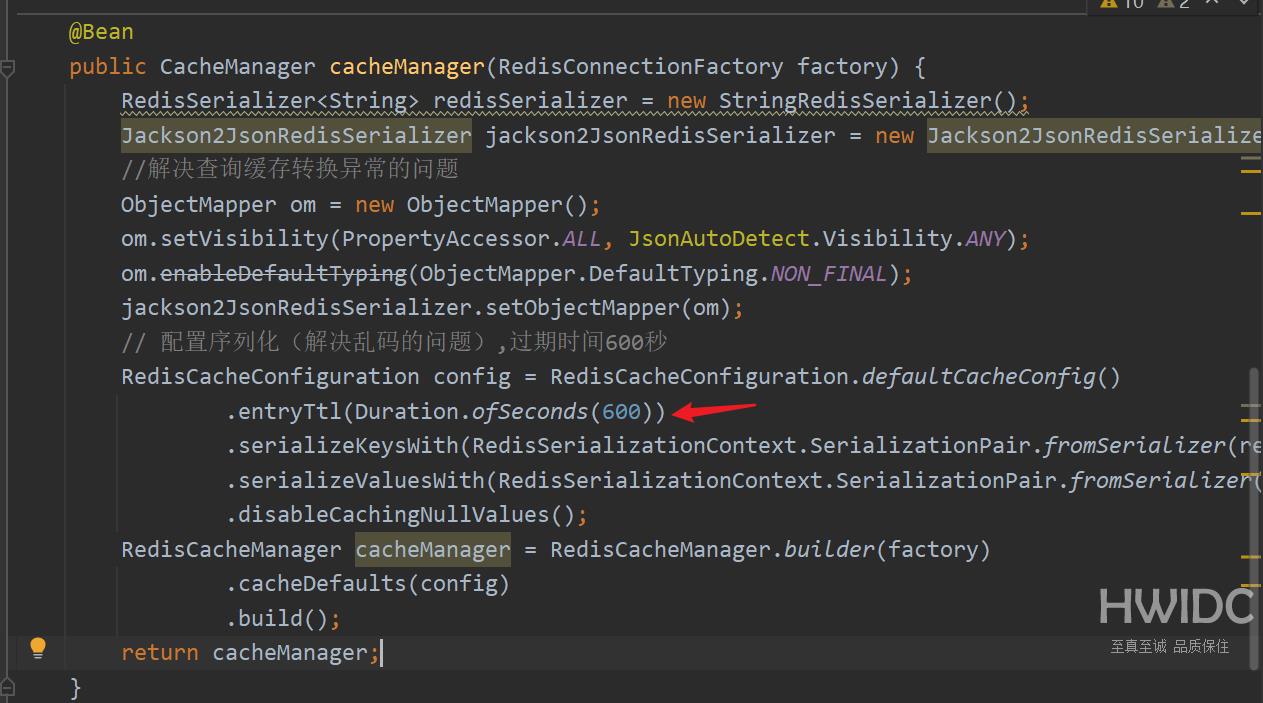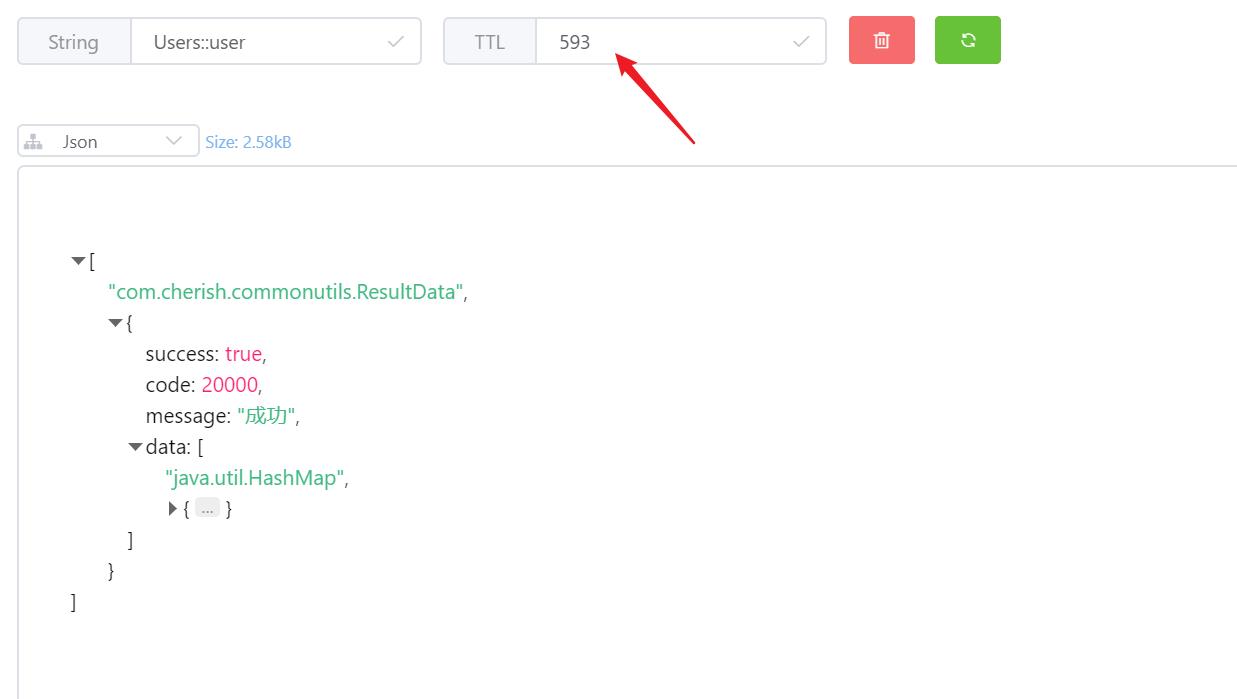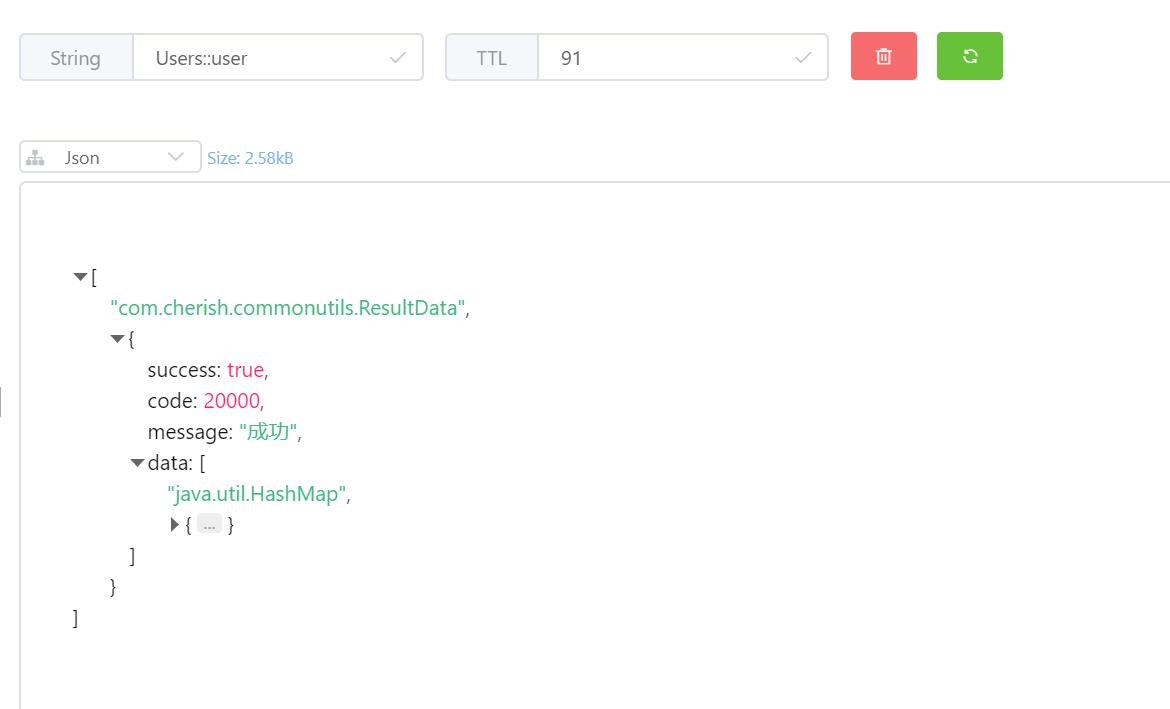springboot与redis整合中@Cacheable怎么使用
首先我们需要配置一个缓存管理器,然后才能使用缓存注解来管理缓存
package com.cherish.servicebase.handler;
import com.fasterxml.jackson.annotation.JsonAutoDetect;
import com.fasterxml.jackson.annotation.PropertyAccessor;
import com.fasterxml.jackson.databind.ObjectMapper;
import org.springframework.cache.CacheManager;
import org.springframework.cache.annotation.CachingConfigurerSupport;
import org.springframework.cache.annotation.EnableCaching;
import org.springframework.context.annotation.Bean;
import org.springframework.context.annotation.Configuration;
import org.springframework.data.redis.cache.RedisCacheConfiguration;
import org.springframework.data.redis.cache.RedisCacheManager;
import org.springframework.data.redis.connection.RedisConnectionFactory;
import org.springframework.data.redis.core.RedisTemplate;
import org.springframework.data.redis.serializer.Jackson2JsonRedisSerializer;
import org.springframework.data.redis.serializer.RedisSerializationContext;
import org.springframework.data.redis.serializer.RedisSerializer;
import org.springframework.data.redis.serializer.StringRedisSerializer;
import java.time.Duration;
@Configuration
@EnableCaching
public class RedisConfig extends CachingConfigurerSupport {
@Bean
public RedisTemplate<String, Object> redisTemplate(RedisConnectionFactory factory) {
RedisTemplate<String, Object> template = new RedisTemplate<>();
RedisSerializer<String> redisSerializer = new StringRedisSerializer();
Jackson2JsonRedisSerializer jackson2JsonRedisSerializer = new Jackson2JsonRedisSerializer(Object.class);
ObjectMapper om = new ObjectMapper();
om.setVisibility(PropertyAccessor.ALL, JsonAutoDetect.Visibility.ANY);
om.enableDefaultTyping(ObjectMapper.DefaultTyping.NON_FINAL);
jackson2JsonRedisSerializer.setObjectMapper(om);
template.setConnectionFactory(factory);
//key序列化方式
template.setKeySerializer(redisSerializer);
//value序列化
template.setValueSerializer(jackson2JsonRedisSerializer);
//value hashmap序列化
template.setHashValueSerializer(jackson2JsonRedisSerializer);
return template;
}
@Bean
public CacheManager cacheManager(RedisConnectionFactory factory) {
RedisSerializer<String> redisSerializer = new StringRedisSerializer();
Jackson2JsonRedisSerializer jackson2JsonRedisSerializer = new Jackson2JsonRedisSerializer(Object.class);
//解决查询缓存转换异常的问题
ObjectMapper om = new ObjectMapper();
om.setVisibility(PropertyAccessor.ALL, JsonAutoDetect.Visibility.ANY);
om.enableDefaultTyping(ObjectMapper.DefaultTyping.NON_FINAL);
jackson2JsonRedisSerializer.setObjectMapper(om);
// 配置序列化(解决乱码的问题),过期时间600秒
RedisCacheConfiguration config = RedisCacheConfiguration
.defaultCacheConfig()
.entryTtl(Duration.ofSeconds(600))
.serializeKeysWith(RedisSerializationContext.SerializationPair.fromSerializer(redisSerializer))
.serializeValuesWith(RedisSerializationContext.SerializationPair.fromSerializer(jackson2JsonRedisSerializer))
.disableCachingNullValues();
RedisCacheManager cacheManager = RedisCacheManager.builder(factory)
.cacheDefaults(config)
// 可以给每个cacheName不同的RedisCacheConfiguration 设置不同的过期时间
//.withCacheConfiguration("Users",config.entryTtl(Duration.ofSeconds(100)))
.transactionAware()
.build();
return cacheManager;
}
}登录后复制1、@Cacheable
标记在方法或者类上,标识该方法或类支持缓存。Spring调用注解标识方法后会将返回值缓存到redis,以保证下次同条件调用该方法时直接从缓存中获取返回值。这样就不需要再重新执行该方法的业务处理过程,提高效率。
@Cacheable常用的三个参数如下:
cacheNames 缓存名称
key 缓存的key,需要注意key的写法哈
condition 缓存执行的条件,返回true时候执行
示例
//查询所有用户,缓存到redis中
@GetMapping("/selectFromRedis")
@Cacheable(cacheNames = "Users",key = "'user'")
public ResultData getUserRedis(){
List<User> list = userService.list(null);
return ResultData.ok().data("User",list);
}登录后复制
第一次查询是从数据库查询的,然后缓存到redis中 使用redis可视化工具查看缓存的信息

第二查询走了缓存控制台没有输出 ,所以走的redis缓存 就是在redis中获取结果直接返回。

@CacheEvict
标记在方法上,方法执行完毕之后根据条件或key删除对应的缓存。常用的属性:
allEntries boolean类型,表示是否需要清除缓存中的所有元素
key 需要删除的缓存的key
//调用这个接口结束后,删除指定的Redis缓存
@PostMapping("updateUser")
@CacheEvict(cacheNames ="Users",key = "'user'")
public ResultData updateUser(@RequestBody User user){
String id = user.getId();
QueryWrapper<User> wrapper=new QueryWrapper<>();
wrapper.eq("id",id);
boolean b = userService.update(user, wrapper);
return ResultData.ok().data("flag",b);
}登录后复制 //不删除redis缓存
@PostMapping("updateUser2")
public ResultData updateUser2(@RequestBody User user){
String id = user.getId();
QueryWrapper<User> wrapper=new QueryWrapper<>();
wrapper.eq("id",id);
boolean b = userService.update(user, wrapper);
return ResultData.ok().data("flag",b);
}登录后复制当我们更新数据库的数据时候,需要把redis的缓存清空。否则我们查询的数据是redis缓存中的数据,这样就会导致数据库和缓存数据不一致的问题。
示例 调用没有加 @CacheEvict 注解的接口修改数据,在查询得到的数据是未修改之前的。

所以在我们调用修改数据的接口的时候需要清除缓存
加上 @CacheEvict 注解 清除对应的缓存此时在查询数据发现数据是最新的,跟数据库保持一致。

过期时间
我们已经实现了Spring Cache的基本功能,整合了Redis作为RedisCacheManger,但众所周知,我们在使用@Cacheable注解的时候是无法给缓存这是过期时间的。但有时候在一些场景中我们的确需要给缓存一个过期时间!这是默认的过期时间

数据有效期时间

自定义过期时间

使用新的redis配置,再次查询缓存到数据看数据有效期

